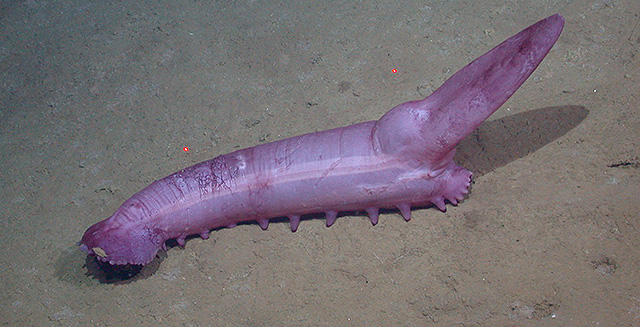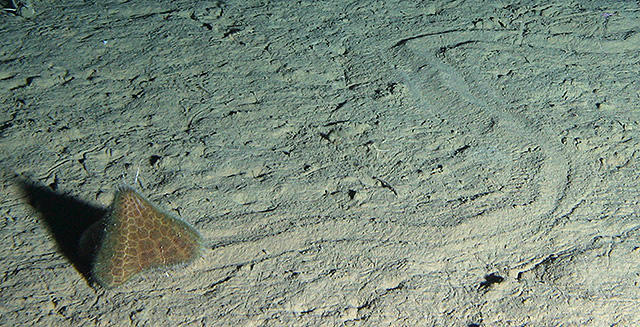Habitat
Seafloor
benthopelagic, occurring just above the seafloor in the bathyal and abyssal zones
Diet
Fishes, invertebrates, and scavenged carrion
Range
Worldwide
About
Super senses help a rattail thrive in darkness.
Food is scarce in the deep sea and, without sunlight, can be hard to find. But those big blue eyes give the rattail an edge. It can glimpse even the faintest flickers of bioluminescence—the “living light” produced by deep-sea animals. Keen eyesight reveals prey, like fishes and squid, darting in the waters above the seafloor.
A rattail relies on other senses, like smell and touch, to find a meal too. It has a nose for rotting carrion, and sensitive barbels on its chin detect small crustaceans or worms wiggling in the mud below.
Humans play a pivotal role in deep-sea food webs too. As fish stocks in the ocean’s sunlit shallows dwindle, fisheries cast their nets to deeper waters. You might see “grenadier” as the catch of the day in restaurants and seafood markets—that’s a deep-sea rattail fish sold under a more palatable market name. Rattails and other deep-sea fishes grow slowly and mature late in life, making them vulnerable to overfishing. The gear used to catch these fishes may harm seafloor habitats or unintentionally catch other species too. Thankfully, effective management for rattail fisheries on the West Coast has reduced the risk of overfishing and habitat damage. The Monterey Bay Aquarium’s Seafood Watch guide can help you make seafood selections that keep ocean health in mind.
Video Clips
Publications
Dunlop, K.M., K.J. Benoit-Bird, C.M. Waluk, and R.G. Henthorn. 2019. Ecological insights into abyssal bentho-pelagic fish at 4,000 meters depth using a multi-beam echosounder on a remotely operated vehicle. Deep Sea Research Part II Topical Studies in Oceanography, 173(104679). https://doi.org/10.1016/j.dsr2.2019.104679
Drazen, J.C., D.M. Bailey, H.A. Ruhl, and K.L. Smith Jr. 2012. The role of carrion supply in the abundance of deep-water fish off California. PloS One, 7: e49332. http://dx.doi.org/10.1371/journal.pone.0049332
Lundsten, L., C.R. McClain, J.P. Barry, G.M. Cailliet, D. Clague, and A. DeVogelaere. 2009. Ichthyofauna on three seamounts off southern and central California, USA. Marine Ecology Progress Series, 389: 223–232. http://dx.doi.org/10.3354/meps08181
Drazen, J.C., B.N. Popp, C.A. Choy, T. Clemente, L. DeForest, and K.L. Smith Jr. 2008. Bypassing the abyssal benthic food web: Macrourid diet in the eastern North Pacific inferred from stomach content and stable isotope analyses. Limnology and Oceanography, 53: 2644–2654. http://dx.doi.org/10.4319/lo.2008.53.6.2644
Barry, J.P., and J.C. Drazen. 2007. Response of deep-sea scavengers to mild hypercapnia and the odor from a dead grenadier. Marine Ecology Progress Series, 350: 193–207.
Drazen, J.C., L.E. Bird, and J.P. Barry. 2005. Development of a hyperbaric trap-respirometer for the capture and maintenance of live deep-sea organisms. Limnology and Oceanography: Methods, 3: 488–498.
Goffredi, S.K., C.K. Paull, K. Fulton-Bennett, L.A. Hurtado, and R.C. Vrijenhoek. 2004. Unusual benthic fauna associated with a whale fall in Monterey Canyon, California.. Deep Sea Research I, 51: 1295–1306. http://dx.doi.org/10.1016/j.dsr.2004.05.009

